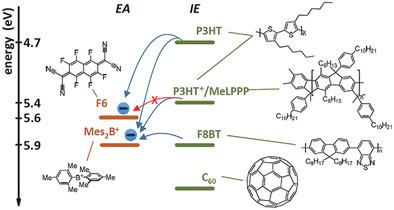Our official English website, www.x-mol.net, welcomes your
feedback! (Note: you will need to create a separate account there.)
An Organic Borate Salt with Superior p‐Doping Capability for Organic Semiconductors
Advanced Science ( IF 14.3 ) Pub Date : 2020-07-06 , DOI: 10.1002/advs.202001322 Berthold Wegner 1, 2 , Dominique Lungwitz 1 , Ahmed E Mansour 1, 2 , Claudia E Tait 3 , Naoki Tanaka 4 , Tianshu Zhai 5 , Steffen Duhm 5 , Michael Forster 6 , Jan Behrends 3 , Yoshiaki Shoji 4 , Andreas Opitz 1 , Ullrich Scherf 6 , Emil J W List-Kratochvil 1, 2, 7 , Takanori Fukushima 4 , Norbert Koch 1, 2, 5
Advanced Science ( IF 14.3 ) Pub Date : 2020-07-06 , DOI: 10.1002/advs.202001322 Berthold Wegner 1, 2 , Dominique Lungwitz 1 , Ahmed E Mansour 1, 2 , Claudia E Tait 3 , Naoki Tanaka 4 , Tianshu Zhai 5 , Steffen Duhm 5 , Michael Forster 6 , Jan Behrends 3 , Yoshiaki Shoji 4 , Andreas Opitz 1 , Ullrich Scherf 6 , Emil J W List-Kratochvil 1, 2, 7 , Takanori Fukushima 4 , Norbert Koch 1, 2, 5
Affiliation

|
Molecular doping allows enhancement and precise control of electrical properties of organic semiconductors, and is thus of central technological relevance for organic (opto‐) electronics. Beyond single‐component molecular electron acceptors and donors, organic salts have recently emerged as a promising class of dopants. However, the pertinent fundamental understanding of doping mechanisms and doping capabilities is limited. Here, the unique capabilities of the salt consisting of a borinium cation (Mes2B+; Mes: mesitylene) and the tetrakis(penta‐fluorophenyl)borate anion [B(C6F5)4]− is demonstrated as p‐type dopant for polymer semiconductors. With a range of experimental methods, the doping mechanism is identified to comprise electron transfer from the polymer to Mes2B+, and the positive charge on the polymer is stabilized by [B(C6F5)4]−. Notably, the former salt cation leaves during processing and is not present in films. The anion [B(C6F5)4]− even enables the stabilization of polarons and bipolarons in poly(3‐hexylthiophene), not yet achieved with other molecular dopants. From doping studies with high ionization energy polymer semiconductors, the effective electron affinity of Mes2B+[B(C6F5)4]− is estimated to be an impressive 5.9 eV. This significantly extends the parameter space for doping of polymer semiconductors.
中文翻译:

用于有机半导体的具有优异 p 掺杂能力的有机硼酸盐
分子掺杂可以增强和精确控制有机半导体的电性能,因此对于有机(光)电子学具有核心技术意义。除了单组分分子电子受体和供体之外,有机盐最近已成为一类有前途的掺杂剂。然而,对掺杂机制和掺杂能力的相关基本了解是有限的。在这里,由硼阳离子(Mes 2 B +;Mes:均三甲苯)和四(五氟苯基)硼酸根阴离子 [B(C 6 F 5 ) 4 ] -组成的盐的独特功能被证明为 p 型聚合物半导体的掺杂剂。通过一系列实验方法,确定掺杂机制包括从聚合物到Mes 2 B +的电子转移,并且聚合物上的正电荷通过[B(C 6 F 5 ) 4 ] -稳定。值得注意的是,前一种盐阳离子在加工过程中会离开,并且不存在于薄膜中。阴离子 [B(C 6 F 5 ) 4 ] -甚至可以稳定聚(3-己基噻吩)中的极化子和双极化子,这是其他分子掺杂剂尚未实现的。根据高电离能聚合物半导体的掺杂研究,Mes 2 B + [B(C 6 F 5 ) 4 ] −的有效电子亲和力估计为令人印象深刻的 5.9 eV。这显着扩展了聚合物半导体掺杂的参数空间。
更新日期:2020-09-10
中文翻译:

用于有机半导体的具有优异 p 掺杂能力的有机硼酸盐
分子掺杂可以增强和精确控制有机半导体的电性能,因此对于有机(光)电子学具有核心技术意义。除了单组分分子电子受体和供体之外,有机盐最近已成为一类有前途的掺杂剂。然而,对掺杂机制和掺杂能力的相关基本了解是有限的。在这里,由硼阳离子(Mes 2 B +;Mes:均三甲苯)和四(五氟苯基)硼酸根阴离子 [B(C 6 F 5 ) 4 ] -组成的盐的独特功能被证明为 p 型聚合物半导体的掺杂剂。通过一系列实验方法,确定掺杂机制包括从聚合物到Mes 2 B +的电子转移,并且聚合物上的正电荷通过[B(C 6 F 5 ) 4 ] -稳定。值得注意的是,前一种盐阳离子在加工过程中会离开,并且不存在于薄膜中。阴离子 [B(C 6 F 5 ) 4 ] -甚至可以稳定聚(3-己基噻吩)中的极化子和双极化子,这是其他分子掺杂剂尚未实现的。根据高电离能聚合物半导体的掺杂研究,Mes 2 B + [B(C 6 F 5 ) 4 ] −的有效电子亲和力估计为令人印象深刻的 5.9 eV。这显着扩展了聚合物半导体掺杂的参数空间。











































 京公网安备 11010802027423号
京公网安备 11010802027423号